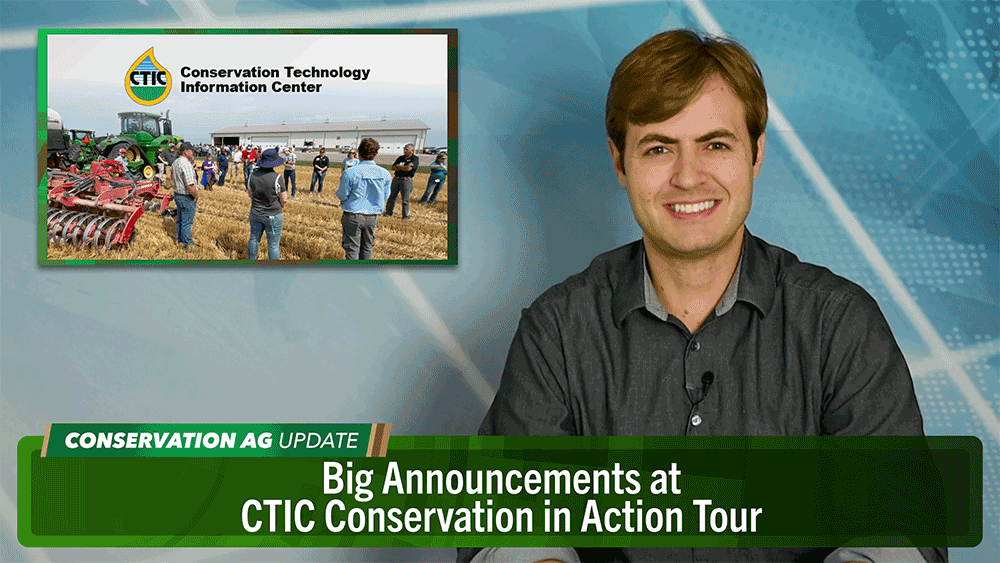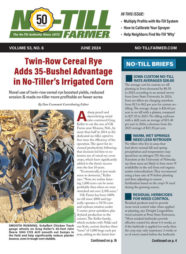In this episode of Conservation Ag Update, we head to Frankenmuth, Mich., for the Conservation Technology Information Center’s 16th annual Conservation in Action Tour. New CTIC executive director Ryan Heiniger makes several big announcements, including a noteworthy surprise for a no-till legend.
Plus, strip-till innovators Ryan and Melissa Shaw give us a peek inside their twin-row strip-till system.
Also in the episode, Iowa no-tiller James Hepp makes a game-changing addition to his Case IH 1200 planter, fellow Iowan Luke Schultes boosts his bottom line with drones, and APV America’s Cameron White shines light on the rise of crop crops and the increasing demand for new equipment.
This episode of Conservation Ag Update is brought to you by Yokohama Off-Highway Tires.
VF tires are constructed with sidewalls that enable them to bear heavier loads and operate at lower inflation pressures than traditional radial tires. In fact, VF tires, like our Alliance AgriFlex+ range, can carry up to 40% more load than a conventional radial tire at the same inflation pressure or operate at up to 40% lower air pressure under the same load. VF tires offer quantifiable improvements on the farm. For example, the ability to carry heavier loads can cut down significantly on fuel use and reduce machine hours, while the ability to operate at lower inflation pressures allows tires to produce larger footprints, which can improve traction and reduce soil compaction. The best part is, you can choose which benefit works best for your operation. Learn More at https://yokohama-oht.com.
TRANSCRIPT
Jump to a section or scroll for the full episode...
- CTIC Hosts 16th Conservation in Action Tour
- Strip-Till Innovators Boost Bottom Line, Soil Health with Twin Rows
- Farmer Feature: James Hepp, Rockwell City, Iowa
- Cover Crop Connection: APV on Rise of Cover Cropping
- Drones Provide Good ROI for Young Farmer
- No-Till Farmer Founder Frank Lessiter Inducted into CTIC Hall of Fame
CTIC Hosts 16th Conservation in Action Tour
Let’s kick things off in Frankenmuth, Michigan, where the Conservation Technology Information Center hosted its 16th annual Conservation in Action Tour.
Farmers, students and researchers gathered to share ideas about conservation practices. Executive Director Ryan Heiniger, in his first year with CTIC, made some big announcements. Number 1 — An in-depth report from a cover crop survey of nearly 900 farmers is coming out in early August. Number 2 — A new Climate Smart Ag Connector app is launching in early 2024. It will help growers find conservation programs in their area. And Number 3 — CTIC is expanding its Operational Tillage Information System.
“One of our long running projects called the Operational Tillage Information System, known as OPTIS, a partnership with Regrow and the Nature Conservancy, that tracks trends for conventional tillage, no-tillage, conservation tillage and cover crops. We’re building that out from 16 states to the lower 48 states in the country, which will include data released later in 2023. That runs consistent with some of CTIC’s early work — it’s using cutting edge satellite technology, algorithms to detect this at a landscape level.”
And there was one more announcement from Ryan — a big surprise we’ll get to that later in the program.
Strip-Till Innovators Boost Bottom Line, Soil Health with Twin Rows
Speaking of big announcements, it’s time to meet the recipients of the 2023 Strip-Till Innovator Award. They are Ryan and Melissa Shaw of Marlette, Michigan!
The Shaws are boosting their bottom line and soil health with cover crops and twin-row planting on their 1,400-acre corn, soybean and sugar beet farm. They bought an ETS SoilWarrior and went all in on strip-till in 2014, which was very uncommon in the thumb of Michigan. Twin-row strip-till is paying off in the form of fewer field passes, lower fuel costs and an average yield bump of 15 bushels per acre. And every season they’re learning something new.
“We’re actually a little different than most. With the twin-row corn, we plant the following year right over the corn stubble. We never move our planting zone. Where we have these cover crops is actually our never-till area, and we’re always planting in that same zone. So, when we do single row sugar beets, we’re actually planting them in the seed bed between the twin-row corn root balls. That took 3-4 years to get brave enough to do a volume of acres. First few years we only did it on 30 here or 40 there to see if we could make it work. And each year we seem to find something that we want to tweak a little more, whether it’s not to dislodge the root balls, or just slice them, run the row cleaners in the fall or not. Each year you tweak it a little bit, and then the weather changes its mind the next year. Mother Nature always wins.”
Learn more about the Shaws’ journey on StripTillFarmer.com. They’ll also talk about their keys to success at the National Strip-Tillage Conference in Bloomington, Ill., August 3rd. Head to striptillconference.com for more information or to register.
Farmer Feature: James Hepp, Rockwell City, Iowa
Stepping into the spotlight this week is first-generation farmer James Hepp of Rockwell City, Iowa.
The no-tiller is in year 4 of his transition from crop insurance salesman to full time corn and soybean farmer. Here’s a look at his heavily modified Case IH 1200 pivot-fold no-till planter. We could fill the entire broadcast talking about all the bells and whistles on this thing. But right now let’s talk about the newest addition to James’ planter, one that he wasn’t quite sure would work.
“This year I decided to throw on some chains I had. I thought there was no way that would ever work in no-till. But I was wrong. They worked amazing. A lot of time when you’re planting you might get about 95% of the trench closed up but you’re not quite happy. These guys seemed to really finish the job. It amazes me, it’s always dragging just a little bit of dirt. And that dirt finds whatever is open. I even flagged stuff that I was concerned about in season. Besides the flag, you couldn’t tell there was a problem. I was sold on them. Very inexpensive. I just never thought they’d work because you’d think corn stalks would get in them, but not the case at all. I highly recommend, everyone should have these.”
Check out the No-Till Farmer YouTube page for a full 10-minute rundown of all the unique features on James’ planter.
Cover Crop Connection: APV on Rise of Cover Cropping
We caught up with APV America's Cameron White and asked about the importance of planting cover crops and the increasing demand among farmers for cover crop equipment. Here’s what he had to say:
People are gonna have to start planting cover crops. We only have a certain amount of soil on the earth, there's no more coming in. So if we can protect that for longer, again, governments are giving grants stipulations to go out and have these farmers plant cover crops. Once that becomes a well practiced thing, I see this business completely getting away from a lot of chemicals and pesticides and herbicides and doing it in a more natural way with cover crops. So I think in the next five to 10 years, we'll see a total increase in cover crop planning. If you look back five years ago, we've already made strides and bounds, from where we were then it, it is becoming a practice that everybody's using. So I see it being a big application.
Mackane, Noah and some of our other editors will be at this year’s Farm Progress Show in Decatur, Illinois so be sure to check back with us in September to see our coverage of all the latest cover crop and conservation ag technology from the event.
Drones Provide Good ROI for Young Farmer
Let’s go ahead of the curve with Luke Schultes. He’s the owner and operator of Viola Drone Service in Audubon, Iowa.
The business uses drones to perform fungicide and pasture spraying, seed cover crops and scout with multi-spectral imagery. Luke’s always finding new ways to use drones on his own farm. He’s using them to apply pre-emergence herbicide, biologicals, cereal rye, red clover into standing soybeans as a relay crop and more. The return on investment has been great, Luke says.
“It’s pretty versatile and cost efficiency is huge. A machine like this that can cover our family farm, costs 10% of what a sprayer would. A late model sprayer from the big manufacturers, as a young farmer, they’re outside of my budget. Having a smaller machine on smaller acres is the name of the game. It’s more efficient. My ROI and margins have been huge, definitely a good investment so far.”
Luke says with drones, half of the work is done before you even get to the field. Planning field boundaries, routes, monitoring wind patterns, and managing the battery are the biggest challenges.
No-Till Farmer Founder Frank Lessiter Inducted into CTIC Hall of Fame
Wrapping things up with our video of the week now. Remember at the beginning of the show I said there was one more big announcement from the CTIC Conservation in Action Tour that we’d get to? Here it is.
Frank Lessiter, the founder and editor of No-Till Farmer, was inducted into the CTIC Hall of Fame. Frank was surprised, he didn’t know this was coming. He was introduced as the “Johnny Appleseed of Conservation Tillage” and the 4th inductee in the organization’s Hall of Fame. Frank has served as editor-in-chief of the monthly No-Till Farmer newsletter for its entire 51 years! He’s been instrumental in helping no-till grow from 33 million acres to 110 million acres in the U.S. today. Congratulations Frank!
Have an interesting photo or video from your farm? Or a story you’d like us to feature on the broadcast? Send me an email at Nnewman@lesspub.com.
And that will wrap things up this edition of Conservation Ag Update. Until next time, for more stories visit no-tillfarmer.com, striptillfarmer.com and covercropstrategies.com. Thanks for stopping by. Have a great day!









Post a comment
Report Abusive Comment